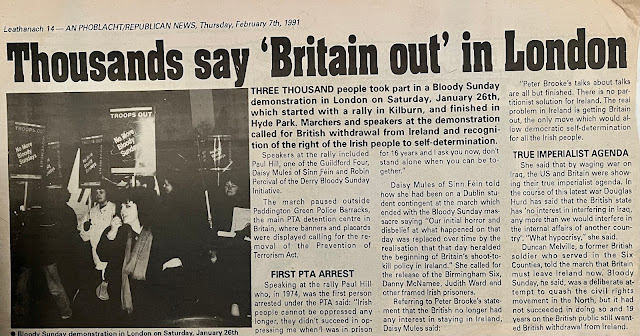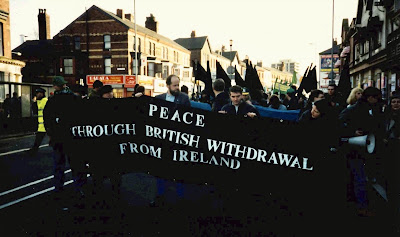The historian Eric Hobsbawm (1917-2012) died yesterday at the age of 95. There's plenty to criticise in his political judgement as he aligned himself with the various phases of the Communist Party of Great Britain from its outright Stalinism to its proto-New Labour 'Marxism Today' period - even if it's not hard to understand why somebody who spent some of his teenage years in Berlin during the rise of Hitler joined the KPD. But his history writing on class and culture was often very nuanced and non-dogmatic. He also wrote extensively on jazz.
One of my favourite short essays of his looks at the early days of jazz in Europe, reflecting on how its popularity related to changing class cultural practices. 'On the Reception of Jazz in Europe' was originally published in 1994 and then republished as 'Jazz Comes to Europe' in the excellent collection 'Uncommon People: Resistance, Rebellion and Jazz' (1998). Here's a few extracts:
'The speed of transatlantic transport was such that ideas, notes and people could already cross the ocean very rapidly indeed. Will Marion Cook's Clorindy: The Origin of the Cakewalk - Cook was later to bring Sidney Bechet to Britain - was performed in 1898 in both New York and London. The foxtrot, the basic dance routine associated with jazz, first appeared in Britain in the summer of 1914. a few months after its first appearance in the USA , and in Belgium in 1915. Jazz had hardly been baptized in the USA when groups under that name already toured Europe. They were there from the middle of 1917.
...the interesting thing about this diffusion is what was being diffused. It was one of several kinds of novel cultural and artistic creation that emerged, in the late nineteenth century, from the plebeian, mainly urban, milieu of Western industrial society, most probably in the specialized lumpenproletarian environments of the entertainment quarter in the big cities, with their specific subcultures, male and female stereotypes, costumes - and music. The Buenos Aires tango which secured for Latin American music a permanent but minor place on the international dance floor at the same time as jazz did, is one example. Cuban music is another...jazz was both novel and, in origin, an art belonging to an autonomous subculture...
...Jazz made its way and triumphed , not as a music for intellectuals but as a music for dancing, and specifically for a transformed, revolutionized social dance of the British middle and upper classes, but also. and almost Simultaneously, the British working-class dance. During the 1900s the upper-crust dance was transformed in two ways. (An expert contemporary witness dates the major change precisely to the season 1910-11.) First urban dancing had already ceased t be a seasonal occupation linked to special occasions. and was being practised all the year round as a regular social and leisure activity. To some extent it was practised privately, but special dancing clubs developed - there were three in Edwardian Hampstead alone - and it occurred in hotels and what were not yet called 'nightclubs' . The tea-dance and the restaurant-dance appeared on a modest scale. Second, the dance lost its formality and ordered succession. At the same time it became simpler, more easily learned and less demanding and exhausting. The crucial change here was that from the turning dance (for example. the waltz) to the walking dance, such as the Boston. a sort of rectilinear waltz, in the early 1900s. It seems clear that these developments reflected a substantial loosening of aristocratic and middle-class conventions, and they are a striking and neglected symptom of the notable emancipation of women in these classes before 1914. The link between the dance revolution, even specifically between the new primacy of rhythm in social dancing, and the emancipation of women, did not pass unperceived. It is noted in the most intelligent or the early jazz books, Paul Bernhard's Jazz: Eine musikalische Zeitfrage (1927)...
...British jazz had a broad popular base, because its uniquely large working class had developed a, for Europe, uniquely recognizable, urbanized, non-traditional lifestyle. Even before 1914 huge popular dance halls had already been built for the holiday demand of specifically proletarian seaside resorts like Blackpool, Morecambe, Margate and Douglas on the Isle of Man. The post-war mania for dancing was immediately met by the new institution of the so-called Palais de Danse, of which the Hammersmith Palais. the first . immediately became a jazz venue by booking the Original Dixieland Jazz Band in 1919. No doubt the music to which the plebs danced would not always be considered jazz today. Indeed, the central tradition of British mass dancing moved away from jazz towards a curious phenomenon called 'strict tempo' dancing, which was to become a competitive sport on British television. Nevertheless, jazz made its mark as a name, an idea, a novel and demotic sound.
The massive dance mania produced an unusually large body of dance-band musicians, mainly of proletarian origin, or at least raised in the environment of the brass-band movement, much appreciated in the industrial areas. These formed the original core of the jazz public... Socially speaking. dance-band musicians, who did rather better in the 1920s than in the depressed 1930s, were on the borders between the skilled workers and the lower-middle classes. It was in the higherparts of this zone that the bulk of British jazz evangelists were to be found before 1945. They were typically self-made intellectuals. In London we find 'Rhythm Clubs' (ninety-eight of which sprang up in Britain between 1933 and 1935) not in middle-class quarters like
Chelsea, Kensington or even Hampstead, but in the outlying districts like Croydon, Forest Gate, Barking or Edmonton...
We can leave aside the reaction of high society and its associated intellectuals. In Britain this was of no great importance though doubtless it pleased Duke Ellington to have the future King Edward VII sit in on drums at a party for his band in London. Much more important, as has been suggested, was the democratic and populist character of the music, which made the Melody Maker state approvingly: [It appeals not only to the fauteuils but to the gallery also. It considers no class distinction.'
...[what Britain] did develop, however, probably in close association with American New Deal radicalism ,was a powerful bonding of jazz, blues, folk and the extreme left, mainly communist but also, marginally, anarchist. For such people jazz and blues were essentially 'people's music' in three senses: a music with folk roots and capable of appealing to the masses, a do-it-yourself music which could be practised by ordinary people, as distinct from those with technical training, and lastly a music for protest, demonstration and collective celebration. Revivalist or Dixieland jazz lent itself unusually well to all these purposes. So much so that at its peak in the 1950s it came closer to turning jazz from the art of a coterie into a mass music than has been achieved anywhere else, except perhaps, for a moment, during the swing boom of the later 1930s in the USA. It is no accident that a typical anthem of the 'trad' jazz fans also became the typical song of the football fans on the terraces : 'When the Saints Go Marching In'. However, it should be noticed that, while revivalist jazz became de facto the music of an age-group in which students, and particularly art students, became prominent for the first time. it was neither consciously nor militantly a youth music... The 'trad' boom prepared the triumph of rock, but only rock turned itself into a conscious manifesto of immaturity'.




























